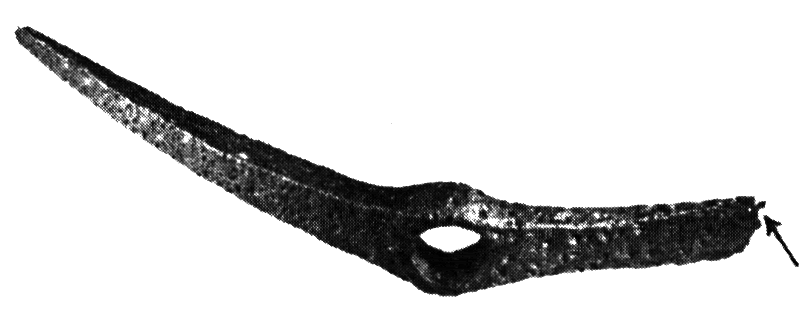Bible and Book of Mormon Steel
 Many critics of the Book of Mormon point to its reference to steel as an obvious proof of its fraudulence. These critics claim that steel technology was not known in either Israel or the Americas in 600 BC. However the King James Version (KJV) of the Bible also makes reference to steel and there are many more that reference iron.
Many critics of the Book of Mormon point to its reference to steel as an obvious proof of its fraudulence. These critics claim that steel technology was not known in either Israel or the Americas in 600 BC. However the King James Version (KJV) of the Bible also makes reference to steel and there are many more that reference iron.
2 Sam. 22: 35 He teacheth my hands to war; so that a bow of steel is broken by mine arms.
Job 20: 24 He shall flee from the iron weapon, and the bow of steel shall strike him through.
Ps. 18: 34 He teacheth my hands to war, so that a bow of steel is broken by mine arms.
Jer. 15: 12 Shall iron break the northern iron and the steel?
Newer versions of the Bible consider the use of steel to be a mistranslation. These newer versions of the Bible translate the Hebrew word “nechushtan” to mean bronze. Critics then contend that the Book of Mormon’s reference to Steel is proof that Joseph Smith plagiarized from the KJV Bible not knowing that the KJV reference to steel was incorrect.
In addition to proving that Joseph Smith was right when he said "We believe the Bible to be the word of God as far as it is translated correctly," I will proceed to demonstrate using linguistic, scientific, historical and archaeological evidence that both the Bible and the Book of Mormon correctly refer to steel.
Aron Pinker suggests that nechushah is better interpreted as “snake-like” and would describe a double convex bow and not a bronze or steel bow. His conclusion is based on the word nechushah being a derivation from the Hebrew word nachash “snake.” The word nachash is used to describe the bronze serpent-pole of Moses. While some infer that nachash refers to the “bronze” pole, others infer that the word is referring to the “snake” because visual focus was the serpent itself and not what it was made of. [www.arts.ualberta.ca/JHS/Articles/article_42.pdf]
Pinker agrees with science that newer Bible translations are in error referring to bronze bows because bronze is a poor material for bow making. Ancient bronze cannot be used as a spring , torsion bar, or bow to store potential energy because bronze lacks shape memory. The elastic modulus of bronze is such that if you bend it, it stays bent. Bronze is too malleable.
Ctesibius or Ktesibios of Alexandria in (285 – 222) BC was the first to invent alloys of Bronze that could be used as springs. Ctesibius developed catapults using bronze springs but they were not better than the standard rope torsion spring. Steel’s carburized micro-structure is what gives it greater tensile strength, elasticity, and shape memory. Modern bronze springs and torsion bars are made of phosphor-bronze today. That said, Pinker still believes the KJV reference to steel is a mistranslation but this conclusion is based on the assumption that steel technology was now known in Israel from 1000 BC to 600 BC. Pinker’s explanation is likely partly correct. But it doesn’t account for the double convex “snake-like” bow breaking. Pictures of ancient steel bows are all double or biconvex. So, in my view, the Bible could be referring to both a steel and double convex bow at the same time. Steel would be likely to break because carbon inclusions in the iron metal which give it its hardness, springiness, and memory, can also result in micro-fractures which can, over time, result in a critical failure and breakage. This is why Nephi's steel bow in the Book of Mormon was said to have "broken" while the wooden bows of his brothers had "lost their spring."
That said, Pinker still believes the KJV reference to steel is a mistranslation but this conclusion is based on the assumption that steel technology was now known in Israel from 1000 BC to 600 BC. Pinker’s explanation is likely partly correct. But it doesn’t account for the double convex “snake-like” bow breaking. Pictures of ancient steel bows are all double or biconvex. So, in my view, the Bible could be referring to both a steel and double convex bow at the same time. Steel would be likely to break because carbon inclusions in the iron metal which give it its hardness, springiness, and memory, can also result in micro-fractures which can, over time, result in a critical failure and breakage. This is why Nephi's steel bow in the Book of Mormon was said to have "broken" while the wooden bows of his brothers had "lost their spring."
Was Steel known to Ancient Israel from 1000-600 BC?
A meteoric nickel-iron (steel) dagger was discovered buried with King Tutankhamun which dates to 1333-23 BC.
A letter from the Hittite King Hassitulis III, written about 1250 BC, makes excuses for not delivering a shipment of iron to Shalmeneser I of Assyria, and presents him with an iron dagger blade.
Homer, in his epic poems the Iliad and the Odyssey lived sometime around 1100 - 880 BC accurately describes steel making. Blacksmiths in Homer's time discovered that "quenching" a forged steel blade by plunging it quickly into liquid dramatically improved its hardness: Homer describes this process in the Odyssey and the blinding the Cyclopes.
By 720 BC, Sargon II of Assyria was using iron lavishly, and nearly 150 tons of unworked iron bars were found in his palace, presumably as some sort of strategic reserve. There is good indirect evidence that the Assyrians did not smelt their iron themselves, but imported it (perhaps from Anatolia) as ready-made bars for their smiths to work into weapons or tools.
Egyptian smiths from 900 BC produced axes that had been steeled, quenched, and tempered, showing that technologically they were well up to the innovations of the smiths elsewhere in the eastern Mediterranean. But the Egyptians did not adopt iron into everyday life until after Egypt was conquered by the Assyrians in 663 BC.
Vered Jericho Sword was carburized iron sword found near Jericho. The sword, which had a bronze/wooden handle, was one meter long and dates to the time of King Josiah, about 600 B.C. There is some debate whether the blade is iron or steel or cast iron. If then blade was iron and the handle bronze, then the blade is steel because Bronze would have made a better blade than either wrought iron or cast iron.
Several Iron I knives have bone handles with pommel end (Tel Qasile St. XII, Beth Shan St. V). The blade is fasten into a slot in the handle.
Wootz steel which is the better than any current steel dates to at least 300 BC when Alexander the Great was given 100 Talents of it along with a sword made from it when he was in India. Some believe that India was making Wootz as early as 500 BC. Hanging on a wall in a materials research centre in India is a this tapestry showing King Poros handing his steel sword over to Alexander the Great after being defeated by him in 330 BC It is said that a piece of steel was packed in a golden casket which in the picture is shown being handed over.
[www.davecullen.com/forum/index.php?topic=26820.msg1261710] The most exciting example of Steel found in Ancient Israel is the Moutn Adir Steel Pick which was found in Galilee in 1976 and dates to 1200-1000 BC. The microscopic analysis of the Mt. Adir Pick by Cornell University material scientists shows "tempered martensite." Martensite can only be formed in iron by rapid cold-quenching carburized molten iron. Therefore, if iron has martensite in it, it is steel. This artifact is proof positive that there was Steel in Israel.[www.lassp.cornell.edu/sethna/Tweed/Martensite_History.html]
The most exciting example of Steel found in Ancient Israel is the Moutn Adir Steel Pick which was found in Galilee in 1976 and dates to 1200-1000 BC. The microscopic analysis of the Mt. Adir Pick by Cornell University material scientists shows "tempered martensite." Martensite can only be formed in iron by rapid cold-quenching carburized molten iron. Therefore, if iron has martensite in it, it is steel. This artifact is proof positive that there was Steel in Israel.[www.lassp.cornell.edu/sethna/Tweed/Martensite_History.html]
Iron and steel was also found in the Americas. The Spanish found Aztec chiefs with knives and daggers made of iron. (Hensoldt 1889). There are also numerous examples of New World natives using meteoric iron. Meteoric iron has nickle on it and makes it resistant to oxidation. The nickle oxidizes protecting the iron. Steel or carburized iron is not protected from rusting and explains why archaeological examples do not exist to the present day.[www.jstor.org/pss/2844401]
Some of the debate regarding the end of the bronze age and the start of the iron age revolves around the discovery of steel. Most scholars know that iron has been known for centuries before it finally overtook bronze. In nearly every characteristic bronze was superior to wrought iron and cast iron. Only when iron was made into steel was iron superior to bronze. Recipes for making steel in 1000-600 BC were closely guarded. However, even if a country did not produce its own steel, Phoenician merchants (Ships of Tarshish) shipped it all over the world. It is believed that a tin shortage (component of bronze) from Great Britain increased the price for bronze and stimulated the local development and production of iron and steel. Also, as was stated before, the conquest of Northern Israel and Egypt by Assyrians armed with steel swords and chariots in 663 BC stimulated the wide-spread adoption of steel production and use.
The reason why Ancient American's didn't gravitate to steel, was that it was difficult to produce in large quantities, and the wooden obsidian swords/clubs they used, were better. Several accounts of Obsidian blades describe how a single blow could decapitate a victim, or amputate a limb. These severed body parts were considered trophies of battle to the Maya and Aztec. Wooden obsidian blades would also have been much lighter than iron, steel or bronze as well.
http://www.experiencefestival.com/a/Steel_-_History_of_iron_and_steelmaking/id/607442













2 comments:
Excellent comment on Book of Moromon vs. Metallurgy (and misguided preconceived notions).
We would NOT expect, however, to find ancient or steel artifacts from purported BoM locations and times for several reasons:
(1) Since the natives that were already there (yes, I hold to Sorenson's hypothesis about "limited" BoM geography) seemed to rely primarily on their wooden/obsidian sword/clubs, they had little reason to investigate other methods of weapon manufacture. In fact, as a "Trekkie", I jokingly postulate that here we have PROOF of visit and influence by ancient Cardassians belonging to the "Obsidian Order", LOL! Seriously, assuming that Nephi (who in addition to his extraordinary divinely inspired talents in shipbuilding probably got some "extra help" in blacksmithing knew how to make articles of steel, likely the Mulekites (Greco-Phoneician influence, perhaps?) also knew. Both cultures would have jealously guarded their secrets from their new neighbors to ensure their survival amongst more numerous neighbords; it also gave them something to barter with!, much the same as the Byzantines and "Greek Fire"). Anything made of iron/steel, especially weapons but even seemingly innocuous items such as bands, straps, or nails would be quite valuable and readily salvaged. In the high moisture and heat of Central America, any discarded item made of iron would crumble to rust and be dissolved into the ground in 150~200 years time, so chances of digging up ANYTHING made of iron or steel after more than 1500 years or so would be somewhere between very remote to downright impossible.
The very fact that Nephi's family had a pink fit about his steel bow breaking is evidence enough that articles made of steel were rare and highly prized. Since prior to whatever knowledge Heavenly Father may have imparted on steelmaking he (or whoever smelted the iron and worked up the steel bow) evidently didn't know about alloying with nickel, tin, or molybdenum to make tool steel, let alone improvising some primtive form of the Basic Oxygen Process, it would be no surprise if corrosion induced by exposure to the salt air and intense heat along the Red or Arabian Seas would cause stress corrosion cracking in the bow and its inevitable failure.
Once again, Smith, who presumably knew little or nothing himself of blacksmithing or steelmaking; got it right!
Thanks for the history! (Your link and explanation go before FAIR in my post!)
grego
Post a Comment